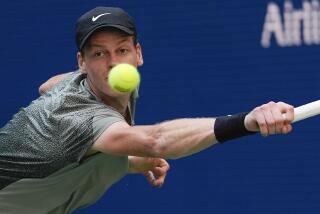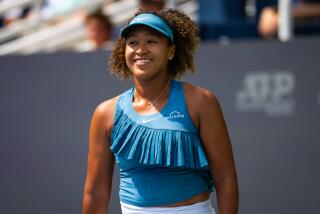Tennis Has Its Own Version of the Brat Pack
- Share via
CARLSBAD — Peace, love and understanding arrived in time for the women’s final at La Costa on Sunday.
It’s easy to explain: the kids have left the arena.
Anna Kournikova, 17, never got here. Venus Williams, 18, hobbled off the court in obvious pain and then said she was fine, getting the point across in her mysterious, moody way. Finally, Martina Hingis, 17, said she gave up in the third set against Mary Pierce, and that her own mother, Melanie Molitor, said she played like a junior.
This was a relatively tame week.
Posing, posturing and postulating were at a minimum compared to the hyper-intense atmosphere of a Grand Slam event.
Venus Williams did not cry and scream at officials over a disputed line call the way she did in the Wimbledon quarterfinals against Jana Novotna. Sixteen-year-old Serena Williams, who took the week off, wasn’t here pulling what was called a junior move at Wimbledon. That’s when she departed with an injury--without shaking hands--on the verge of a third-round defeat and then played mixed doubles the next day.
No one pouted and cried the way Kournikova did when officials denied her the opportunity to take a bathroom break at the French Open when she was on the verge of losing in the round of 16 in the fading light.
Here, there was just one major in-your-face-blast, and that came from Pierce, who put away a sitter by whacking the ball right at Hingis. But Pierce, 23, separated herself from the teens by actually apologizing.
Teen tennis means you never have to say you are sorry.
The youth--at least two of them: Hingis and Serena Williams--are headed for the Acura Classic starting today at the Manhattan Country Club in Manhattan Beach. Hingis is the top seeded player, followed by Lindsay Davenport, Arantxa Sanchez Vicario of Spain and Monica Seles, if she is healthy enough to compete.
Seles beat Davenport in the final in 1997, and looking back, Manhattan Beach was one of the early stages of the fast-emerging brash attitude of the kids. That was where Hingis asked Davenport whether she wanted to get broken in the first game when she decided to serve. Davenport got the final word when she knocked off Hingis in three sets.
Certainly, the teenagers had confident predecessors in the modern age of women’s tennis. Billie Jean King and Rosie Casals were hardly shy. People forget that Pam Shriver once had a few choice words for Tracy Austin when they went to shake hands at the net after a contentious match.
The major difference is age, as well as the age of hype. Long before Kournikova posed for Rolling Stone, there were articles touting her promise when she was 11. Venus and Serena Williams were well-known years before they landed in the top 50, and landed a multi-page spread in Vogue.
“I think the youngsters have so much more attitude,” said Seles, the former No. 1 player who has won nine Grand Slam titles. “With us, you had to earn that to have an attitude. The only one who has arrived in terms of feeling that she’s good is Martina [Hingis] because she’s earned it.
“The other ones have not yet. They might.”
King sees something of a common thread between the generations.
“I think in the ‘70s, just the way we were, some of us, myself included were considered pretty outrageous and on the cutting edge,” she said.
“Now in the ‘90s with the young players, personally I’m pretty happy. I think the only setback they can have, when you speak big, you have to back it up. Sometimes you can speak big, and if you fall, life becomes more difficult for you. That’s something you have to deal with when you say, ‘I’m No. 1, I’m better.’ ”
The words have been said enough on the tour to make the teenagers sound as if they could fit in nicely in the NBA, with the other cocky millionaires. Only the youth of the NBA are kids who should be in college. On the women’s tour, the youngsters are kids who would normally be in high school.
Just listen to them roar:
--”We don’t see anyone else--or we don’t want anyone else to try to stop us,” Venus Williams, on her plan, to be No. 1, competing only with her sister Serena.
--”She said it again? Nothing new anymore. Well, so far she’s not. One day if I’m probably not playing anymore she could get there,” Hingis on Venus Williams’ plans for No. 1.
--”No, she doesn’t hit the ball that hard,” Kournikova on Lindsay Davenport.
--”I don’t think any player on the tour wants to lose to Anna ever,” said Davenport after beating Kournikova. “ . . . She can say what she wants. She’s still young. I think she’ll mature a little and stop worrying so much about what people think about her and her image.”
--”You can’t say it is cocky. Once you are No. 1 in the world, you win 12 of the 17 tournaments, if you don’t have the confidence, who should have the confidence?” Hingis on her own attitude.
--”It shows me that she didn’t beat me. I lost. That means I’m better a little bit than her,” Kournikova after losing to Venus Williams.
--”At Grand Slams, it starts the second week on, the real tournament for the stars. This [the first week] is like the warmup,” Hingis said.
Last year, the WNBA’s slogan was “We’ve Got Next.” On the tennis tour, the swaggering brings to mind another phrase: “Quien es mas macho?”
But the sniping sells.
“Sure there’s a little mano a mano or womano or womano or whatever it is,” said Bart McGuire, the WTA’s CEO.
“This is not trash-talking in the sense you get in some other professional sports. This is pretty low-key stuff. And if it weren’t a women’s sport, it would almost pass without notice.”
Said tennis great Chris Evert: “The way I look at it, they’re saying what we felt, but we didn’t say. They’re coming out and saying it. So they’re being bold. I mean, it makes for interesting press. . . . In our day, the women got along so well, if there’s somebody that was acting up a little bit, we’d just confront her. Maybe that’s what the players should do.”
That might be more apt to happen on the men’s tour. The top men--with some notable exceptions--are a closer group.
“Women seem to do that a lot more than guys do,” Patrick Rafter said of the tour infighting. “It is really unfortunate for the women’s game that they are like that. But the men I think we like to have our mates. I think women are more independent than guys. But I always look forward to my friendship on the tour with the guys.”
McGuire sees the talk as a product of a competitive atmosphere.
“The stuff they say about each other doesn’t make me cringe,” he said. “And I’ll tell you why. I suppose all of us say things to the press that we wake up the next morning and say, ‘I wish we had said that differently.’
” . . . I kind of like the way Venus said it a few weeks ago. She said, ‘I’m not cocky and arrogant. I’m confident and I tell the truth.’ To me that’s a nice way to put it.
“We’re really fortunate to have a lot of people who are both good athletes and charismatic people. They’re good copy; it’s good theater. . . . Sometimes, they’re a little more unvarnished than the views of a 45-year-old male golfer. And they’re likely to blurt things out.”
Seles sees a downside to the incessant talk of No. 1 at an early age. Her late father and coach Karolj certainly never encouraged her to proclaim she was going to be No. 1 when she debuted on the tour at age 14.
“If I would have a child, I would not want them to say that,” she said. “That puts extreme pressure on them. And if they don’t make it, they’ll feel like failures for a long time. I think one player on the tour is going through that quite a lot now.”
The issue of respect is another area of contention. The younger players not only don’t show each other a lot of respect, they don’t always look up to the older generation and its accomplishments either.
Hingis recently criticized Steffi Graf in an interview with Tennis magazine, saying that Graf’s time had passed and that the game was faster and more athletic now.
Graf did not respond to that specific criticism but did recently talk about the attitude on the tour.
“I don’t think you could have called me arrogant at all, at any stage, at least I hope,” she said. “You can have a certain arrogance, and I think that’s fine. But what you should never lose is the respect for others. That’s what I grew up with. I’ve always looked up to Martina [Navratilova] or Chris [Evert] and the other players.”
Seles, who upset Evert in her second tournament as a professional player, was in awe of both Navratilova and Evert as a youngster.
“I really feel you’ve got to respect the people who have [been there],” Seles said. “The same way our generation has to respect the players from Billie [Jean King] to [Evonne] Goolagong to all of them who have done so much for the game.
“It’s just sad to see some of the younger players have no idea about the history of the game or about certain players. Those are things that are so important because they [the kids] are the future of the tour.
“It’s not that they will be. They are already. And you have to [instill] that in them at this age. Otherwise, time will pass.”
(BEGIN TEXT OF INFOBOX / INFOGRAPHIC)
TOURNAMENT AT A GLANCE
* What: $450,000 Acura Classic.
* Where: Manhattan Country Club, Manhattan Beach.
* When: Today through Sunday.
* Top players: Martina Hingis, Monica Seles, Lindsay Davenport, Arantxa Sanchez Vicario, Nathalie Tauziat and Serena Williams.
* Tickets: (213) 480-3232.
(BEGIN TEXT OF INFOBOX / INFOGRAPHIC)
Today’s Featured Matches
STADIUM COURT, 10 A.M.
* Julie Halgard-Decugis, France
vs. Kimberly Po.
COURT 4, 10 A.M.
* Anne-Gaelle Sidot, France
vs. Ai Sugiyama, Japan.
STADIUM COURT, 7 P.M.
* Fang Li, China
vs. Irina Spirlea, Romania
More to Read
Go beyond the scoreboard
Get the latest on L.A.'s teams in the daily Sports Report newsletter.
You may occasionally receive promotional content from the Los Angeles Times.











